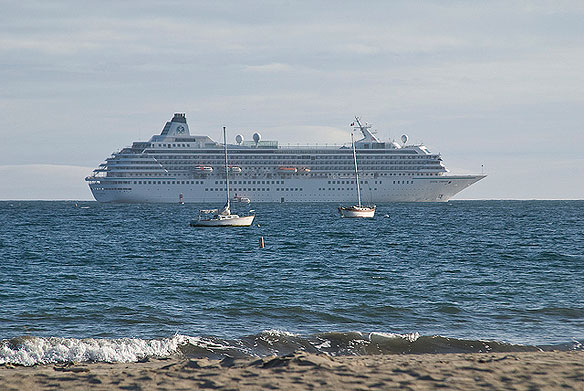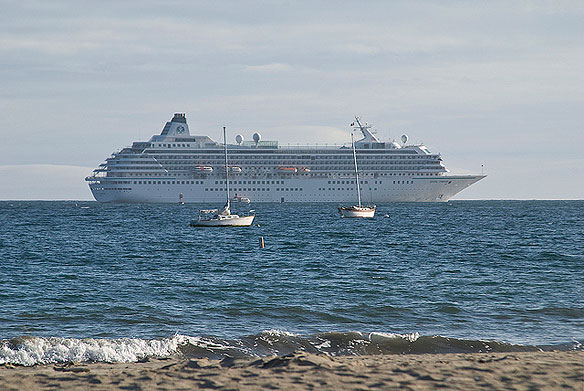
Cruise ship, Santa Barbara, California. Photo source: ©© Damian Gadal
EPA-Release Date: 02/09/2012. Feds Approve California Sewage Ban and Create Largest Coastal No-Discharge Zone in the Nation.
Federal action is unprecedented in geographical scope, will prohibit the discharge of more than 22 million gallons of treated vessel sewage to shorelines and shallow waters in Calif. each year.
EPA- News Release:
SAN FRANCISCO – U.S. EPA’s Pacific Southwest Regional Administrator Jared Blumenfeld will today ()2-09-2012) sign a rule that will finalize EPA’s decision and approve a state proposal to ban all sewage discharges from large cruise ships and most other large ocean-going ships to state marine waters along California’s 1,624 mile coast from Mexico to Oregon and surrounding major islands. Today’s action establishes a new federal regulation banning even treated sewage from being discharged in California’s marine waters.
“This is an important step to protect California’s coastline. I want to commend the shipping industry, environmental groups and U.S. EPA for working with California to craft a common sense approach to keeping our coastal waters clean.” said Gov. Jerry Brown.
“By approving California’s ‘No Discharge Zone,’ EPA will prohibit more than 20 million gallons of vessel sewage from entering the state’s coastal waters,” said Jared Blumenfeld.
“Not only will this rule help protect important marine species, it also benefits the fishing industry, marine habitats and the millions of residents and tourists who visit California beaches each year.”
This action strengthens protection of California’s coastal waters from the adverse effects of sewage discharges from a growing number of large vessels.
Several dozen cruise ships make multiple California port calls each year while nearly 2,000 cargo ships made over 9,000 California port calls in 2010 alone. EPA estimates that the rule will prohibit the discharge of over 22 million of the 25 million gallons of treated vessel sewage generated by large vessels in California marine waters each year, which could greatly reduce the contribution of pollutants still found in treated vessel sewage.
State Senator Joe Simitian (D-Palo Alto) authored Senate Bill 771, the Clean Coast Act which prohibits all commercial ships from dumping hazardous waste, sewage sludge, oily bilge water, “gray water” from sinks and showers, and sewage in state waters. Simitian’s SB 771 also required California to petition the federal government for a ‘No Discharge Zone’ to enforce the bill’s anti-dumping provisions.
“This is a great day for the California coast, which is far too precious a resource to be used as a dumping ground,” said Simitian. “This ‘No Discharge Zone’ – the largest in the nation – protects our coastal economy, our environment and our public health.”
“California’s coastal waters will no longer serve as a sewage pond for big ships,” said Cal/EPA Secretary Matthew Rodriquez. “For too long, pollution from these vessels has endangered our marine environment, jeopardized public health and threatened the coastal communities that rely on recreation and tourism dollars. I commend U.S. EPA for helping us ensure that our coastline remains pristine.”
California’s coastal waters are home to a wide variety of unique, nationally important marine environments that support rich biological communities and a wide range of recreational and commercial activities.
Four national marine sanctuaries, a national monument, portions of six national parks and recreation areas, and more than 200 other marine reserves and protected areas have been established to protect California’s unique marine resources.
The National Oceanic and Atmospheric Administration has already implemented similar vessel sewage discharge bans in the four California marine sanctuaries that it oversees. Recreational and commercial uses of California’s coastal waters are equally important.
Seventy-seven percent of the State’s population lives on or near the coast and annually, over 150 million visitor-days are spent at California beaches. California ranks first in the nation as a travel destination and its beaches are the leading destination for tourists. California’s commercial fishing industry also relies upon clean water to help preserve and restore coastal fisheries.
Under the Clean Water Act, states may request EPA to establish vessel sewage no-discharge zones if necessary to protect and restore water quality. In 2006, following passage of three state statutes designed to reduce the effects of vessel discharges to its waters, the State of California asked EPA to establish the sewage discharge ban. After releasing the proposed rule in 2010, EPA considered some 2,000 comment letters from members of the public, environmental groups, and the shipping industry before finalizing the regulation.
“California’s economic health is tied to the health of our oceans and beaches,” said Charles Hoppin, Chair of the State Water Resources Control Board. “Pollution from cargo and cruise ships directly threatens public health, marine life and our economy. This led to our request to declare the whole coastline a no discharge zone so that we could provide equal water pollution protection along our precious coastline.”
Today’s prohibition is unprecedented in geographical scope. In contrast to prior no-discharge zones under the Clean Water Act, which apply in very small areas, the new ban applies to all coastal waters out to 3 miles from the coastline and all bays and estuaries subject to tidal influence. Other California no discharge zones for ten bays and marinas remain in effect for all vessels.
“Big ships make for big pollution but unfortunately, responsible disposal of sewage from ships hasn’t always been a given in California,” said Marcie Keever, oceans and vessels project director at Friends of the Earth. “The actions taken today by the U.S. EPA, the State of California, and the thousands of Californians who supported the Clean Coast Act mean that cruise lines and the shipping industry can no longer use California’s valuable coastal and bay waters as their toilet.”
Consistent with the State’s request, today’s prohibition applies to all passenger ships larger than 300 tons and to all other oceangoing vessels larger than 300 tons with sewage holding tank capacity.
“The Pacific Merchant Shipping Association shares the concern for protection of California’s marine environment. Our member companies are dedicated to the facilitation of trade while also minimizing any associated environmental impacts,” said John Berge, Vice President of the Pacific Merchant Shipping Association.
In addition to today’s discharge prohibition, other vessel sewage discharges will continue to be regulated under existing Clean Water Act requirements, which generally require sewage to be treated by approved marine sanitation devices prior to discharge.
The State is also continuing to implement and strengthen other efforts to address sewage discharges from smaller vessels, including recreational boats, to state waters.
EPA’s action complements our ongoing ocean protection efforts including strengthening the existing Vessel General Permit, development of a Vessel General Permit for smaller vessels, and our efforts to reduce marine debris such as plastics and other human-generated debris.
The California No Discharge Zone will be submitted today to the Federal Register and be published within 3-5 business days.









